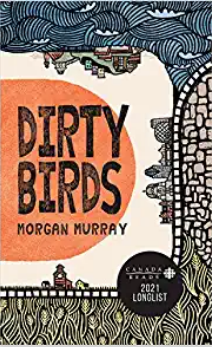Just before I read Dirty Birds, I attempted to read Quichotte by Salman Rushdie, and I was surprised by the parallels. Both protagonists are on a quest to make a woman love them. Although Rushdie’s protagonist is old and Murray’s is young, both are naïve and deluded. Road trips are part of each novel, and so is satire—Rushdie’s for the cult of personality and big pharma, among other things, Murray’s for the Montreal art scene and the young man as artist. I found Murray’s book more successful and a lot funnier.
Milton Ontario is a hapless young man who is not only utterly average but characterized by the extent of his naiveté and inexperience. He gets an idea in his head that he wants to be a poet, even though he writes atrocious poetry (at first dedicated to the love of his life, Ashley, and later to the love of his life, Robin), so he sets out from his small town for Montreal and a tiny room he has rented sight unseen in a dilapidated, filthy house full of students and would-be artists. There he attempts to enter the art scene and falls in love with Robin, the maker of a seven-minute documentary entitled Dirty Birds, who is almost unaware of his existence.
Milton stumbles through a series of horrendous jobs horrendously performed and meets a cast of rowdy, raucous characters. He inadvertently starts a riot and gets to meet his hero, Leonard Cohen, only to find he is a mob boss (where I think the novel starts to go a bit astray). In among all this silly action is a series of footnotes enlightening us about the history of Canadian mistreatment of indigenous peoples, Newfies, and French-Canadians, among others.
Although I think it gets a little carried away with itself (and I didn’t like the part about the late, great Cohen), for the most part, this novel is a hoot.



